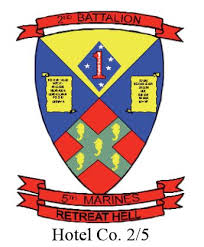On 26 October 1955, the military was reorganized by the administration of South Vietnam’s President Ngô Đình Diệm, who then formally established the Army of the Republic of Vietnam (ARVN) on 30 December 1955.
Although the American news media has often portrayed the Vietnam War as a primarily American and a North Vietnamese conflict, the ARVN carried the brunt of the fight before and after large-scale American involvement and participated in many major operations with American troops from 1966 – 1971 including us in Hotel 2/5. Our experience fighting alongside the ARVN’s was that they were fearless, fought hard, and sacrificed their freedoms and their lives to free their country from communism.
 ARVN troops pioneered the use of the M113 armored personnel carrier as an infantry fighting vehicle by fighting mounted rather than as a “battle taxi” as originally designed, and the armored cavalry (ACAV) modifications were adopted based on ARVN experience. The ARVN suffered 254,256 recorded deaths between 1960 and 1974, with the highest number of recorded deaths being in 1972, with 39,587 combat deaths died during the war that year.
ARVN troops pioneered the use of the M113 armored personnel carrier as an infantry fighting vehicle by fighting mounted rather than as a “battle taxi” as originally designed, and the armored cavalry (ACAV) modifications were adopted based on ARVN experience. The ARVN suffered 254,256 recorded deaths between 1960 and 1974, with the highest number of recorded deaths being in 1972, with 39,587 combat deaths died during the war that year.
During the American intervention in Vietnam, the ARVN was reduced to playing a defensive role with an incomplete modernization and transformed again following Vietnamization, it was upgraded, expanded, and reconstructed to fulfill the role of the departing American forces. The ARVNS were many times used in the direct battles as we Marines were used in blocking positions when fighting the NVA in Quang Nam Province in the late 1960s.

From 1969 to 1971, there were about 22,000 ARVN combat deaths per year. Starting in 1968, South Vietnam began calling up every available man for service in the ARVN, reaching a strength of one million soldiers by 1972. In 1970, they performed well in the Cambodian Incursion and were executing three times as many operations as they had during the American-led war period. However, the ARVN equipment continued to be of lower standards than their American and other allies, even as the U.S. tried to upgrade ARVN technology.

United States’ experience with the ARVN generated a catalog of complaints about its performance, with various officials saying, ‘it did not pull its weight, ‘content to let the Americans do the fighting and dying’ and ‘weak in dedication, direction, and discipline. ‘The South Vietnamese President remained prone to issue instructions directly to field units, cutting across the entire chain of command. Major shortcomings identified by U.S. officers included a general lack of motivation, indicated, for example, by officers having an inclination for rear area jobs rather than combat command, and a continuing desertion problem. The officer corps was still their biggest problem. Leaders were often inept, being poorly trained, corrupt, and lacking morale.
in April 1975 less than a month after Huế fell, Saigon fell; South Vietnam ceased to exist as a political entity. Without an operational government, the sudden and complete destruction of the ARVN shocked the world.
There were hundreds of soldiers, officers, and colonels who committed suicide, making a decision not to live under communism. Five ARVN generals committed suicide in late April to avoid capture by the PAVN/VC and potential reeducation camps. The victorious Communists sent over 250,000 ARVN soldiers to prison camps wherein they were routinely tortured and murdered some for a period of eleven consecutive years. The communists called these prison camps “reeducation camps”.

